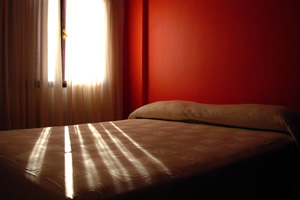 Reducing allergens in the bedroom should significantly improve the quality of sleep, especially as the bedroom is usually the place we escape to if we’re feeling tired or ill.
Reducing allergens in the bedroom should significantly improve the quality of sleep, especially as the bedroom is usually the place we escape to if we’re feeling tired or ill.
Deep, refreshing sleep not only enables our bodies to heal more efficiently but also helps us cope more positively with life.
Setting up the bedroom as a ‘chemical free oasis‘ is a good idea if living with other people makes it difficult to eradicate chemicals elsewhere. Even if compromises have to be made, any reduction in allergens is likely to have some benefit.
Dust, moulds and pollen are common allergy triggers, but it is also helpful to consider chemicals in clothes, fabrics, furniture, bedding and toys. If you are very sensitive you may also be reacting to electromagnetic fields and geopathic stress.
Dust
-
- Wash or vacuum floors, rugs, curtains and bedding regularly. Dust mites cannot survive at temperatures above 56°C or below freezing, so any soft toys that will not stand washing can be placed in a bag in the freezer for a couple of hours.
- Dust-mite barrier covers are available in untreated, organic cotton to seal mattresses, pillows and duvets. Where possible vacuum, wash or freeze existing bedding before sealing.
- Avoid bunkbeds if the person on the lower bunk is allergy prone.
- If children play on the floor, consider replacing carpet with a hard surface and washable rugs. Avoid newly fitted carpets as they will have been treated with an enormousquantity of chemicals.
- Keep clutter to a minimum, removing anything that is unnecessary. Store toys etc in cupboards or boxes with lids.
- Dusting with a damp cloth is preferable to using feather dusters which just move dust around.
- After dusting or vacuuming, ventilate the room. The dust will need time to settle, so don’t clean immediately before bedtime.
Bedding
 Bedding is next to your face and skin all night. To reduce chemical exposure, opt for untreated, organic bedding. All bedding should be washed before using.
Bedding is next to your face and skin all night. To reduce chemical exposure, opt for untreated, organic bedding. All bedding should be washed before using.
When buying new, choose natural fillings for pillows, mattresses and duvets. (Cover new bedding with dust-mite barrier covers straight away.) Existing mattresses can be covered with a thick blanket or mattress cover to reduce fumes from fire retardant chemicals.
Switch to a washing powder that does not contain petrochemicals, optical brighteners or fragrances. Some asthmatics may also need to avoid enzymes. Environmentally friendly brands usually list all ingredients. Avoid using fabric conditioner as it does not rinse off the fabric. For alternative washing powders, take a look at our Links Directory.
Wash bedding once a week at 56°C or higher to denature dust mite allergens. Dry washing outside in the sunlight whenever possible.
Make sure your bed is not sited in an area affected by geopathic stress. As a temporary measure, you can place aluminium foil or untreated cork tiles between the mattress and bed base. Refresh the cork or foil every couple of weeks.
Materials
Consider what furniture, ornaments and toys are made of. Hypersensitive sufferers should aim to replace synthetic materials with natural ones such as wood, wool, kapok or cotton. Make particular efforts to avoid foam or polystyrene filled furniture, pliable resins (such as the ‘water’ found in vases of synthetic flowers), and new rubber. Chairs upholstered in synthetic fabric can be covered with a thick blanket or bath towel.
Replace items made of flexible plastic, PVC or polyethene, for example, bin liners, carrier bags, sellotape, mouse mats, DVD and computer game cases.
 Secondhand furniture is preferable to new, as furnishings are usually glued together and varnished with solvents and other chemicals. Additionally, some sufferers may find they react to the smell of new pine wood. Avoid new furniture made of MDF or chipboard as it contains vast quantities of formaldehyde.
Secondhand furniture is preferable to new, as furnishings are usually glued together and varnished with solvents and other chemicals. Additionally, some sufferers may find they react to the smell of new pine wood. Avoid new furniture made of MDF or chipboard as it contains vast quantities of formaldehyde.
New carpets, sofas and fabrics are likely to have been treated with an enormous variety of chemicals including bleach, moth-proofing and fire retardants. Where possible, opt for secondhand or organic textiles.
Leave anything new in a warm, well-ventilated room for 6 weeks before bringing it into the bedroom. This gives time for any chemical smells to outgas (evaporate). CD cases will not outgas if they are stacked next to each other. Plastic, MDF, chipboard items and plastic/rubber coated electrical wiring will take much longer than 6 weeks to outgas.
Bring new items into the bedroom one at a time, so that allergies to new products can be easily dealt with.
Formaldehyde
Store books, magazines, papers, greetings cards and cardboard boxes outside the bedroom as both the paper and the print are likely to contain solvents or formaldehyde. Keep drawing or writing paper in a cupboard or in a box with a lid.
Particle boards such as MDF, hardboard and chipboard usually contain vast quantities of formaldehyde that take years to outgas (evaporate). Avoid new MDF furniture, picture frames, shelves or laminate floors.
The coatings on modern radiators often emit formaldehyde when heated; they can be the single largest source of formaldehyde in the home. To remedy this, you could: i) seal the radiators with a specially designed paint; ii) replace them with non-painted radiators (eg chrome or polished aluminium); iii) invest in a good quality air purifier that specifically states it can remove formaldehyde gas.
Ventilation
Keep the room well ventilated by opening a window at least once a day. If the outside air is full of fumes, pollens or moulds, consider buying an air purifier. You can filter out some pollen spores by taping a piece of material over the window opening.
Avoid using air fresheners. Instead, keep rooms fresh through regular cleaning and airing; keep pets out of the bedroom.
All perfumes, essential oils and toiletries such as cosmetics, deodorant and moisturisers should be stored well away from the bedroom. Most are specifically designed to have airborne fragrances which will not be restricted by drawers or cupboard doors.
Nail polish, nail varnish remover, waterproof marker pens and some printer cartridges all contain strong solvents. Keep them well away from the bedroom.
Replace commercial cleaning products with natural alternatives – take a look at our Links Directory for ideas! Hypersensitive sufferers should look for unscented products.
Mould
Get rid of all patches of mould. Check around window seals and behind large pieces of furniture, especially if they stand against outside walls.
Houseplants have high levels of unseen moulds on leaves and in the soil. If you are sensitive, move flowers and plants out of the bedroom.
Make sure clothes and bedding are thoroughly dried and aired before storing.
If you are very sensitive to moulds or pollen you may need to dry bedding, flannels, towels and handkerchiefs inside.
Mould is less likely to grow if the room is kept consistently warm and dry.
Keep humidity levels down by not drying clothes or towels in the bedroom.
Read more about: Is Mould making you ill?
Clothes
Store clothing in well-ventilated cupboards or drawers.
Remove any dry-cleaned or ‘easy iron’ clothing from the bedroom as it is likely to have been treated with chemicals such as formaldehyde.
New clothes should be washed a couple of times to remove the worst of the chemical finishes.
New shoes are full of solvents so store them well away from the bedroom.
Electricity
Be aware that electrical items give off fumes when they are switched on. Either make sure the room is well-ventilated, or avoid having computers and TVs in the bedroom.
To avoid disturbing the body’s natural systems, turn off or unplug electrical equipment before sleeping.
Keep mobile phones out of the bedroom, and preferably turned off.
Move the bed slightly away from the wall to reduce an electrical charge from the house wiring.
Remove mains or battery-operated clocks, watches and remote controls from your bedside table so they are not next to your head.
If you have any other ideas, suggestions or comments, why not visit our Forum?







